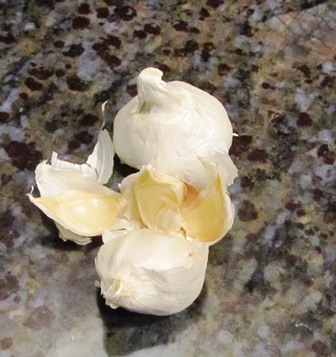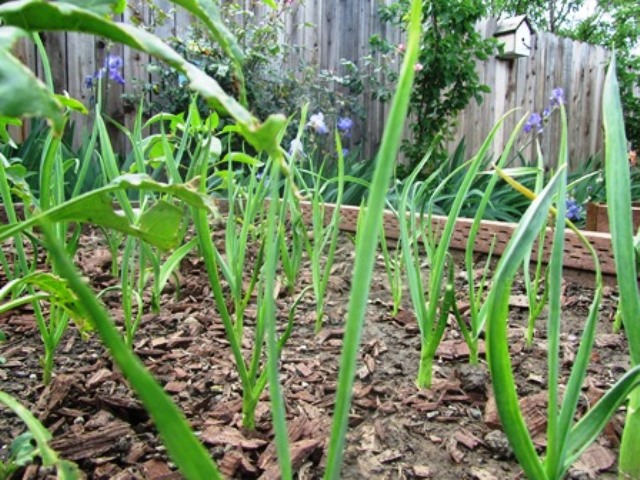How to Grow Garlic
In the Bay Area, September to late October is the optimum time to sow garlic for a spring harvest. Or, you can plant garlic in prepared beds in spring for an autumn harvest.
Get your garlic cloves into garden soil or containers before the first frost to ensure enough time during the rainy winter months for the bulb to grow. Watch for the appearance of its strap-shaped leaves.

Why Grow Garlic?
Garlic is an ancient herb that adds a wonderful pungent complexity to a wide variety of culinary creations. In a kitchen garden, vegetable patch, or potager garden where herbs and vegetables grow alongside berries and fruit trees, garlic works as a beneficial companion plant because its pungent odor acts as repellent for many common garden pests.
Garlic has medical uses, too. In many parts of the world, the herb has been used as treatment for hypertension, bronchial inflammation, fungal skin issues, and high cholesterol. Modern science makes note of garlic compounds as having anti-inflammatory, anti-fungal, and anti-bacterial properties as well as benefiting the immune system.
Choose Softneck or Hardneck Garlic

Garlic falls into two main types: the shorter, softneck variety and the long hardneck type that is often braided. Gardeners can choose from dozen of varieties in each type. Local DIY garden centers or nurseries generally offer garlic during the optimal times for planting it. Notably, elephant garlic, while bearing the name of garlic, is not garlic at all but rather a relative of the leek family whereas true garlic is related to the onion (Allium) family.
Following the following six simple tips can ensure success at growing garlic as a kitchen staple.
- Plant each clove (pointed side upward, round base downward) in full sun, about 4 inches deep and 4 to 6 inches apart. Space the rows 6 to 8 inches apart. Use well drained-loamy soil to grow your garlic.
- Grow the garlic in raised beds with soil amended with compost and fertilizer if you have clay soil since clay is unsuitable for growing garlic. The point is to plant this herb in a nutrient-rich, well draining but moisture-retentive soil.
- Water well when planting; do a weekly watering thereafter. For autumn planting, the Bay Area’s rainy season might provide enough water to keep the herb happy without extra watering through winter, but it’s no guarantee. Drought conditions have prevailed through the rainy season of past years and then there were 17 atmospheric river storms in 2022-2023. Your best bet is to keep checking on the garlic until it is well established.
- Harvest any garlic scapes, the long, green flowering stems of hard-neck garlic, before they flower. The garlic bulbs will be significantly smaller if the scapes are permitted to flower.
- Control weeds. If allowed to grow, they can take over your garlic plants.
- Keep an eye out for pests like dry bulb mites (watch for stunted, twisted leaves and galls indicating that these wormlike pests are present). Other pests include leaf-miners, parasitic wasps, and garlic bloat nematodes (roundworms that feed on the plant, rendering the bulbs soft, brown, and unusable).
Enjoy reading about gardening and other country-living topics, check out my cozy mystery novels. They are chocked full of tips on gardening, beekeeping, and country cooking as well as offering a great mystery in the style of Agatha Christie.

Harvesting Garlic
Now that it’s the last week of July, the garlic in my Henny Penny Farmette garden is showing signs of maturation. When the bottom stalk leaves turn brown and dry, it’s an indicator that the bulbs beneath the soil are ready for harvesting.
Garlic is easy to grow, harvest, cure, and store. If you like to cook, you already know how important garlic is as a culinary staple. Since it doesn’t require much space, you can grow it in a large pot or flower box on your patio. It’s well worth your time and effort.
The leaves of a garlic plant sprout from the bottom of the stem upward. The oldest bottom leaves will indicate maturity of the bulbs.
Use a fork to carefully loosen soil around the base of each garlic plant. It’s a good idea not to pull from the stems as they might snap. You don’t want to bruise or otherwise damage the garlic bulbs.
Once the plants are harvested, you’ll need to cure them by drying them in a cool, dark place. You could also tie them by their stems in small allotments and hang in protected shed or ventilated closet where the air can circulate around the bulbs.
- Cloves of garlic ready to be peeled and prepared for cooking
When the garlic has been cured, remove any remaining soil. Braid the stems to hang the bulbs in your kitchen for easy access when cooking (these braids also make great gifts to friends who cook). Or, leave about 1/2 inch of stem in place before cutting off the rest and storing the garlic in a cool, dark, place.
Softneck Garlic: This type of garlic is preferred for braiding and includes the varieties of Creole, artichoke, and some Asian types of garlic. Softneck garlic grows best where winters are mild and this type of garlic stores for a longer period of time than hardneck types.
Hardneck Garlic: If you want garlic adaptable to cold winter climates and a taste that is closer to wild garlic, this is the type of garlic of choose. It includes the rocambole, purple stripe, and porcelain varieties.
_______________________________________________________________
If you enjoy reading about farmette topics, gardening, and keeping chickens and honeybees, check out my series of cozy mysteries from Kensington Publishing in New York.
Click on this link: http://tinyurl.com/ya5vhhpm
Click on this link: http://tinyurl.com/yd7pz7af
 Facebook
Facebook Goodreads
Goodreads LinkedIn
LinkedIn Meera Lester
Meera Lester Twitter
Twitter










